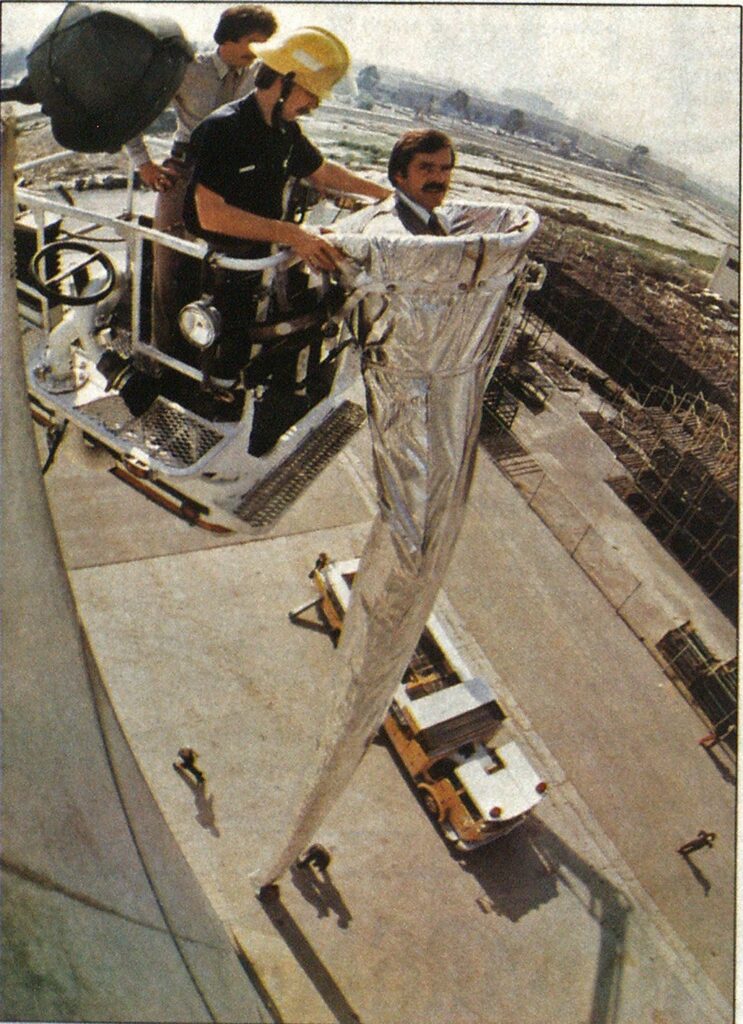
Slide tube to safety
DISPATCHES
Evacuating large numbers of civilians from structural fires, particularly high-rise fires, is a strain on both firefighters’ stamina and the manpower available for firefighting operations.
A portable emergency evacuation system, developed by Palladium International Corporation, is reported to quickly and safely transport people from the upper floors of a fire building—without the need for firefighters to accompany them.
This slide tube system has the unique advantage of being able to transport injured, unconscious, and handicapped victims quickly and easily, according to a Palladium official. A firefighter places an evacuee into the tube feet first. The descent speed can be controlled by the firefighter on the ground twisting and untwisting the slide.
The system is made of three tubes: the slide tube (innermost tube) is constructed of Cordura, a high-strength, nylon yarn fabric; the middle tube, made of a lightweight Cordura, has restricting bands for controlling the speed of descent; the heatshield tube (outer tube) is made of Nomex (an aluminized, heat-resistant material) and sewn with Kevlar thread. According to Palladium, this outer tube protects against heat, flames, smoke, and gases.
The innermost and middle tubes are attached to a yoke covered with Nomex and extending from the outer tube. All three tubes are attached to a metal bracket by bolts and nuts. The rescue system is hung by its brackets onto a tower ladder’s bucket, a window, or a balcony, its snap mechanism released, and the slide pulled out of its case and tossed over the front of the bracket so that it hangs vertically.
This “one-step operation” takes only minutes to set up, says the company official, and depending on tube length, the system weighs approximately one pound per foot. Each system is custom made to fit individual height requirements.
The Cove Fire Commission in Palm Springs, CA, which encompasses the Rancho Mirage, Palm Desert, and Indian Wells districts, is the first fire department to have purchased this system since it came on the market a year ago.
According to a department official, the 100-foot rescue system was purchased primarily for use at a local hospital. There are also a number of high-rises being constructed in the area. To date, the department has not had need to use this device in an actual incident, and they are fashioning an adaptor to be able to hang the system on their Snorkel’s bucket. —FE


This photo is a training essay in itself. It depicts practically every aspect of an efficient hazardous material incident response, which is only gained through effective training.
The members in the foreground (the contaminated or hot zone) operate with carefully rehearsed moves that will mitigate the incident. They are in constant view of each other, and always under the watchful eye of the properly equipped safety/ ‘relief members (in the background). This backup team waits unaffected at the hot zone entry point. Behind them are stretched hose lines for protection, vapor direction, and decontamination.
Properly equipped firefighters and response vehicles are located further into the cool zone as directed by the command post, located (in this case) in the vicinity of the chief’s vehicle.
Good engine company tactics are seen in this photo of a fire in Syracuse, NY. The primary line, properly flaked out in front of the occupancy, is meeting with obvious success. This may be seen by the steam billowing from the front windows as the initial attack line aggressively moves through the fire apartment. A second handline, properly stretched and charged, isabout to be advanced as a backup line to the second floor. When assured of control on the second floor, this line advanced through the interior to extinguish fire extension in the attic. Good, aggressive engine tactics combined with efficient and coordinated ventilation techniques made this fatal blaze a two handline operation.
The fire, caused by careless smoking, had overcome a second-floor tenant prior to the arrival of Syracuse units. Quick, effective operations resulted in an immediate, successful primary search. Resuscitative efforts, however, proved fruitless.
Photo by Captain Jorge Battle of the Syracuse, NY, Fire Department.


